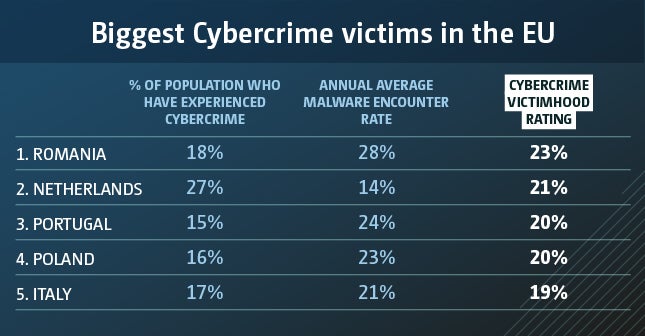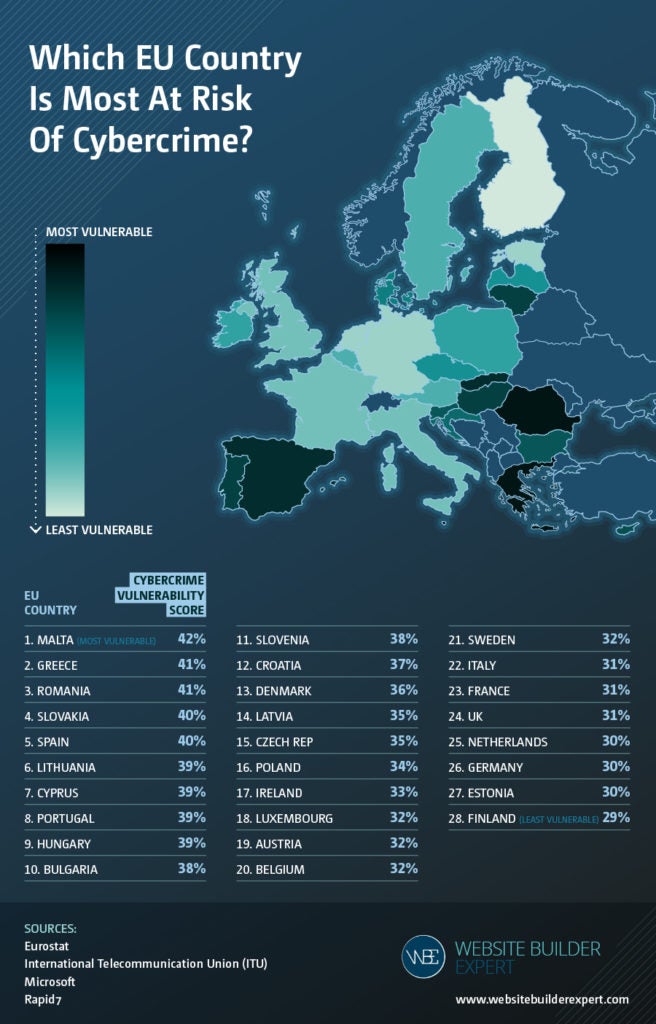Which EU Country Is Most Vulnerable To Cybercrime?
If you click to purchase a product or service based on our independent recommendations and impartial reviews, we may receive a commission. Learn more
Why should you care about cyber security?
Keeping visitors to your website safe is an important consideration for anyone building a website. It’s even more important to bear in mind when running an ecommerce website because users are trusting you with their important financial details. If your site can’t protect these details then the user’s trust will be broken and this can have serious knock-on effects for your reputation.
Cyber security is becoming an increasingly important topic and a lot of the questions we field from readers center around safety features available for their websites.
This isn’t surprising considering the number of high-profile cyber attacks that have occurred in the first half of 2017 alone – we’ve had the WannaCry ransomware, the CloudBleed leaks and the potential exposure of voter records by hackers.
We wanted to get an idea of just how vulnerable countries might be to cybercrime and decided on looking at the European Union due to the wealth of publicly available data, number of countries involved and the socio-economic diversity between these 28 countries.
What factors did we look at at in our study?
This research looked at a range of factors that we felt were important in measuring just how vulnerable countries were to potential cyber crime. These factors were:
1.How many residents had already experienced cybercrime
Looking at data from the European Union, we were able to estimate the percentage of each EU nation’s population that had been a victim to cybercrime.
2.How often residents are encountering malware and viruses each year
 We were able to work out just how regularly European residents encountered malware and viruses (which are used to infect computers and commit cybercrime) by looking at publicly available data from Microsoft.
We were able to work out just how regularly European residents encountered malware and viruses (which are used to infect computers and commit cybercrime) by looking at publicly available data from Microsoft.
3.Each nation’s commitment to cyber security initiatives
We rated individual country commitments to fighting cyber crime by using data from the Global Cybersecurity Index, a survey that measures factors such as legal frameworks, technical capability, organizational measures, capacity building and cooperation with other countries.
4.How exposed internet connections were in each country
Your internet connection is made up of lots of little connection points called ‘nodes’. Each of these nodes is responsible for transferring a different type of information, e.g. the POP3 node, which you may recognise from your smartphone, is a node that transfer mobile email information. In each country a lot of these nodes are public-facing, which means they are exposed and potentially vulnerable to attack. Therefore the fewer nodes a country has exposed the more protected its internet users are. We gathered data on the number of exposed nodes there were in each EU country by examining the National Exposure Index created by Internet security company, Rapid7.

What did the results tell us?
The results indicate that Malta, located just south of Italy in the Mediterranean Sea, was the country most vulnerable to potential cybercrime attacks despite the fact that Maltese people rank in the middle of the pack for actual malware and cybercrime encounters.
This is because our study wanted to look at vulnerability and Malta’s exceptionally high percentage of exposed internet connections (73%), lack of cybersecurity legislation and poor international co-operation means that Malta’s population, despite encountering cybercrime slightly less than their European neighbours, are actually at far more risk in the long run with few protective or preventative measures in place.
Greece, Romania and Slovakia made up the rest of the top five most vulnerable nations.
 At the opposite end of the scale, we found Finland to be the most cyber-secure country in the EU with a vulnerability rating of just 29% – not too bad at all! We deemed Finland to be the most secure because it has the lowest cybercrime encounter rate in Europe and is one of the most prepared nations too, with robust cyber security commitments in place and a high percentage of non-exposed internet connections.
At the opposite end of the scale, we found Finland to be the most cyber-secure country in the EU with a vulnerability rating of just 29% – not too bad at all! We deemed Finland to be the most secure because it has the lowest cybercrime encounter rate in Europe and is one of the most prepared nations too, with robust cyber security commitments in place and a high percentage of non-exposed internet connections.
Estonia emerged as a close contender to Finland with a vulnerability score of 30% reflecting changes made to government security strategies, legal frameworks and organisations in response to statewide cyberattacks in 2007.
Germany, the Netherlands and the U.K. made up the rest of the top five least vulnerable nations, which must come as a relief to these economic powerhouses.
 Elsewhere – and somewhat surprisingly – we found that the Iberian Peninsula of Spain and Portugal were among the nations most vulnerable to cyber attacks and crime. Spain in particular has a shockingly high proportion of internet connections exposed to potential threats (76%) as well as a very middling commitment to cybersecurity legislation and initiatives.
Elsewhere – and somewhat surprisingly – we found that the Iberian Peninsula of Spain and Portugal were among the nations most vulnerable to cyber attacks and crime. Spain in particular has a shockingly high proportion of internet connections exposed to potential threats (76%) as well as a very middling commitment to cybersecurity legislation and initiatives.
Methodology
We used a number of formulas to generate our results, which you can find below. We will use the following abbreviations for simplicity:
- VICTIM. = How many residents had already experienced cybercrime
- ENC. = How often residents are encountering malware and viruses each year
- GCI. = Each nation’s commitment to cyber security initiatives
- NODE. = Number of non-exposed internet connections in each country
- XNODE. = Number of exposed internet connections in each country
Overall Result
To obtain a measure of overall cyber vulnerability we took the average of sum of all four measures:
(VICTIM. + ENC. + [1 – GCI.] + NODE.) / 4 = Vulnerability Score
We had to use [1 – GCI.] because every for other measure a higher score indicated a worse performance. The opposite was true for the GCI security commitment scores, where a higher figure indicated a better result. By inverting the GCI score we could obtain a measure that effectively scored countries on their ‘lack of commitment’ to cyber security initiatives.
Most / Least Prepared
We identified the most and least prepared countries by taking the average score of:
(GCI. + XNODE.) / 2 = Most / Least Vulnerable
By combining the Global Cybersecurity Index with scores for exposed nodes, we could work out which countries were most and least prepared for cybercrime.
Biggest / Smallest Victims
It can be next to impossible to quantify the exact cost of cybercrime on a country, so the next best option for us was to look at which populations were the biggest and smallest victims of cybercrime. We did this by combining malware encounter rates with cybercrime victimhood rates:
(VICTIM. + ENC.) / 2 = Biggest / Smallest Victims
Full Results
Sources
We used the following sources to complete this research project:
European Union
ITU Global Cybersecurity Index
Microsoft
Rapid7
Found This Research Helpful?
Question – Did this research benefit you? Leave a comment below.
Do you know anyone who can benefit from this research? Send them this page or click on the share buttons on the left.
You’ll be helping us out by spreading the word about our website, and you’ll be helping them out!





3 comments